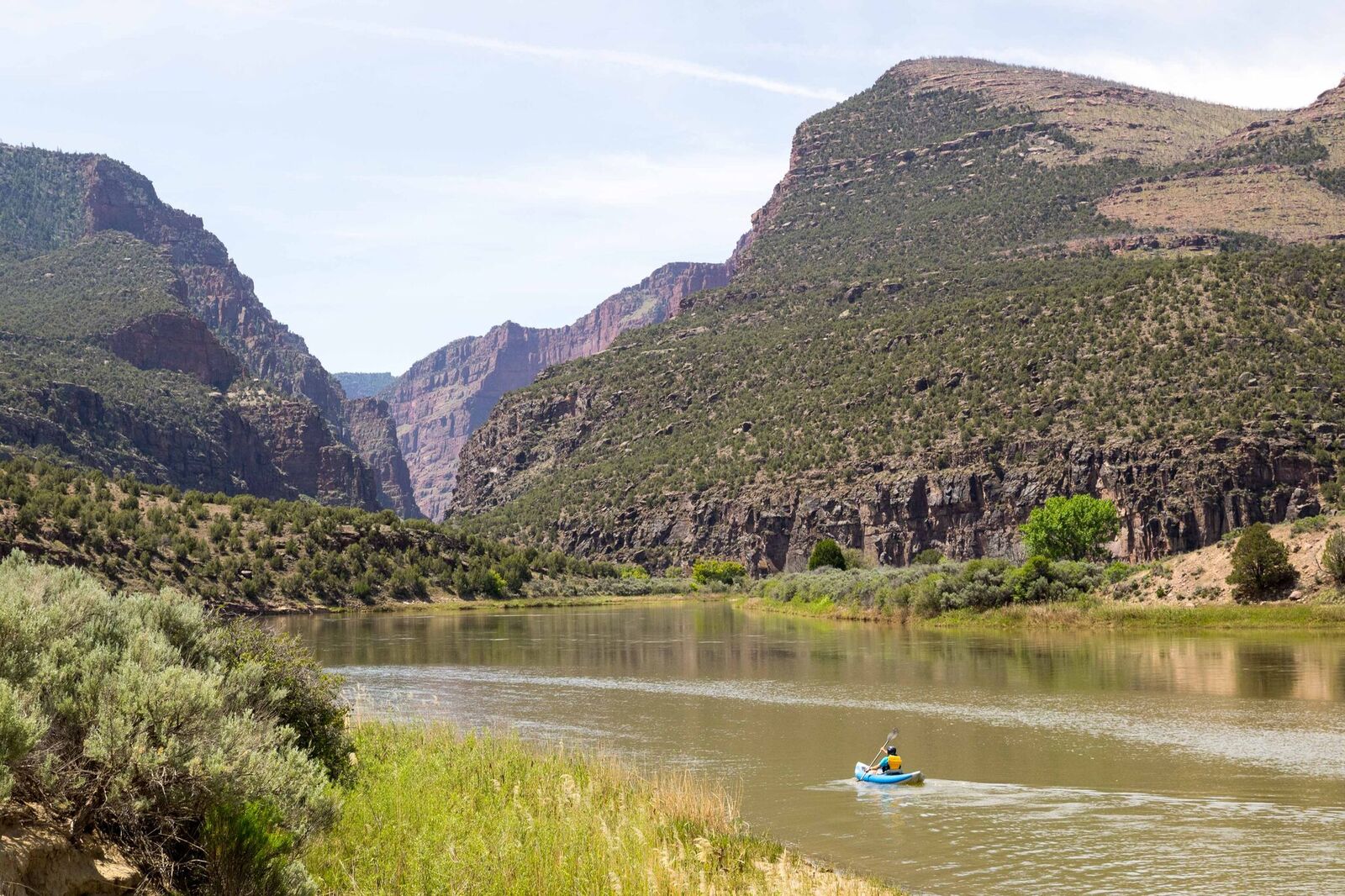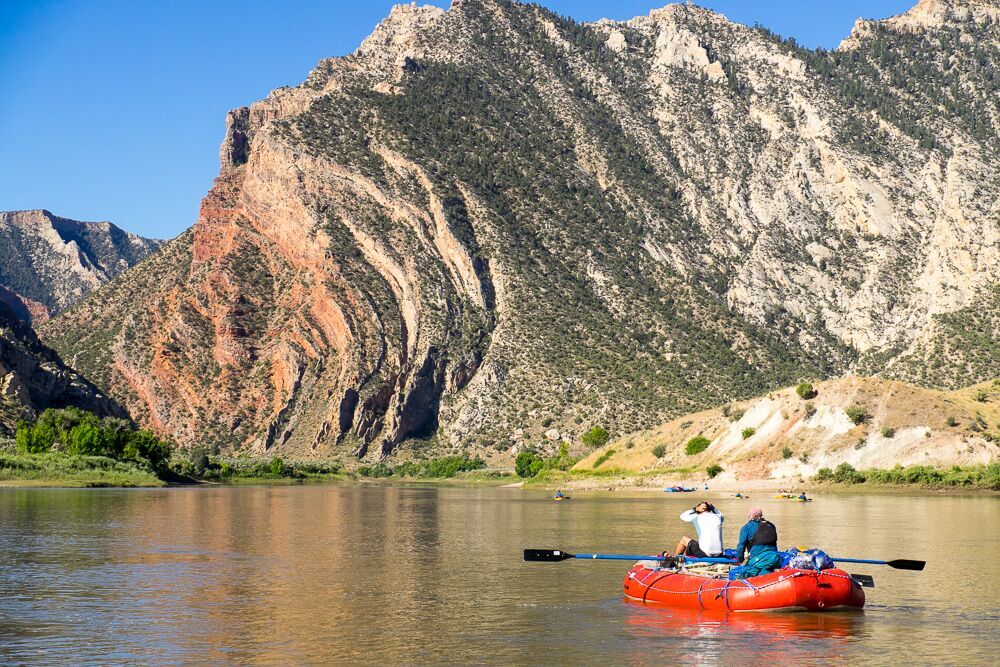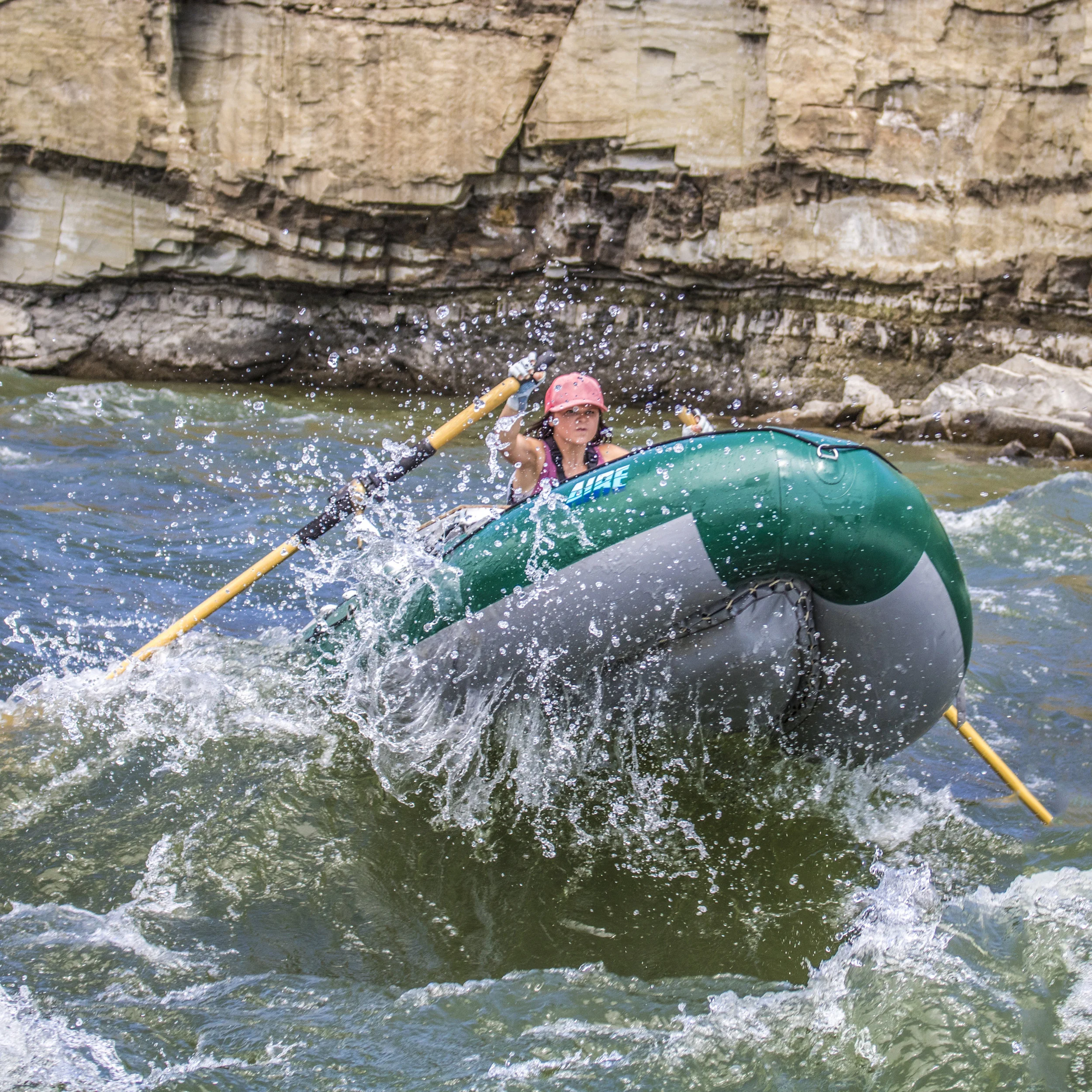A Return to Rafting for the John Wesley Powell Route
Returning to Rafting
We were at put-in for the upper Gauley, and I was sorting straps like a medic in a war movie frantically searching for morphine. To say I felt out of my element was an understatement. After kayaking in the Ozarks and Southeast during the past decade, my six seasons of California raft guiding before that felt like a set of vivid but patchy memories.
Despite a few warm-up day-trips, I was still struggling to recall basic items. Like which side the oar-clip faces on the pin. Or which D-rings to loop when attaching the frame. I kept unrolling the wrong strap lengths, and now the floor of the raft looked like a pit of nylon snakes.
“Umm…” Kev was standing nearby. Him and Danny were nervously eyeing the river rushing past. “We better get going, or we’ll miss the water.”
I glanced around. We were the last group at put-in. Hurriedly, we stuffed excess straps into our vehicle and pushed off down the river—me rowing and Kev paddling in the raft, with a playboat strapped down, and Danny in his creek boat. I was still tying on drybags as we floated through the first riffles.
Our plan was a two-day shakedown trip, camping that night in the little-paddled middle section. The overall purpose was early practice for our 21-day winter Grand Canyon trip in fourteen months. While researching that trip, I’d become swept up in the dramatic history of John Wesley Powell’s expedition. In 1869, they rowed (with many portages) about 1000 miles down the Green and Colorado Rivers, exploring many of the West’s most iconic canyons, including a first descent through the Grand. They started from Green River, Wyoming, with ten men in four boats. By the time they exited the Grand Wash Cliffs three months later, there were only six men in two boats. And what happened along the rugged route in between quickly became the stuff of legend.
Immediately, I pondered following the entire Powell route, possibly using a mix of kayaks and rafts. But first, a short-term goal for the Gauley was to get all three of us some big-water time on the oars. That way, we’d have enough experienced rowers within our group of kayakers and friends to rotate between rafts and hard-shells during longer expeditions.
It was a mid-fall day, with turning leaves, gray skies, and dry-suit temps. As I rowed into Initiation rapid, and large waves and holes began splashing over the bow, I wondered if we’d been overconfident in our choice of shakedown river, a favorite fall kayaking destination. On many of our kayak trips, we’d often take a paddle-cat or two for variety and friends. But even with these 10- to 12-foot paddle rafts, the approach was similar to kayaking, mostly aggressive forward strokes and quick maneuvering.
Though I hadn’t rowed in at least eight years, I kept reminding myself about the importance of planning ahead with a loaded 14-footer. Use powerful backstrokes to set-up above rapids, switch to forward strokes to build momentum and punch through holes, and do whatever works to adjust along the way. Luckily, the first dozen rapids went well—at least while we had water. We shore- and boat-scouted as needed. I threaded holes and boulders, while regaining muscle memories for placement, turning, and timing. We dropped through Pillow just off the wall, Kev could have slapped it with his paddle if he wanted. Then he dropped in a few quick bow strokes, as we zipped cleanly left of Volkswagen rock.
In fact, everything went so well—I won’t tempt fate by saying swimmingly—that we fell victim to complacency at Sweet’s Falls. The water was dropping by that point, so we shared notes on the line and motored into the drop like we otherwise would have kayaking. As we came over the lip, I realized I had committed the standard mistake—being too far left. What might have been an easy correction in a kayak was impossible in the barreling raft.
We impacted Dildo Rock on left front corner, the raft taco-ing in the middle. Luckily, I’d rigged the four-bar frame somewhat loose, and it simply rotated up to the side as the raft folded underneath. The playboat strapped to the stern snapped upward and smacked me on the helmet, as if saying, way to go, dummy. Then we spun off to the right, and the hard-knock lesson was earned.
“This is why I hate rubber!” shouted Kev, one of the best class V kayakers I know.
The next day, all three of us rotated between rowing and kayaking. Things didn’t go as hoped. Danny rowed us into the shore three times before asking, “What’s wrong with your raft?” My arms were so tired (probably from over back-stroking, followed by over-forwarding to compensate, the day before) that I limped into a mellow hole and surfed for a few solid minutes.
And Kev kept defaulting to his killer kayaker instincts, trying to forward the raft away from rocks and holes, which offered up key reminders about high-siding and flat-perching. At one point, he got completely exasperated from spinning—while we were heading straight toward a shallow sieve at full speed.
“We’re going in!” I yelled.
“You take it!” shouted Kev, as he tossed up his hands and hopped out of the seat.
“I’m not sure there’s time,” I said, jumping into the seat. There was a small ledge hole oncoming, and I instinctively recalled things like angles and tracking. With a big right back stroke, I turned the raft 45 degrees to the ledge hole. With a casual slurp, we were sucked directly left away from the shallow sieve.
“See, nothing to it,” I joked, still in shock.
“Then why were you so dramatic about it?” said Kev, with an awkward chuckle. We stared at the shallow boulders that could have flat-wrapped us for hours.
The message was clear. Returning to rafting would be tougher than once thought.
A few weeks later, our kayaking buddy, Hudson, unveiled a brilliant creation. He’d welded his own oar frame for an 11-foot Shredder. The result was a sporty cataraft so light and nimble, it allowed for rowing practice with the corrective responsiveness and speed of a kayak. This was a lot of fun.
Training to Return to the Powell Route
Over the coming year, the two rafts—a 14’ NRS and 11’ Shredder—appeared on many of our favorite kayak trips. Sure, the occasional hiccup continued, but rowing skills improved by leaps and bounds. We ran our backyard Ozarks run, the Saint Francis, at highwater. I vividly recall wincing as one friend flat-wrapped on a downed tree, while another knocked out a first-descent through a previously unknown tree-tunnel. (No trees were harmed during this production.)
Me? I had way more than my share of perches at the upper and middle Ocoee runs. An overnight on the Arkansas River in Colorado ended with a highwater luge through Royal Gorge and a lesson about cam buckle management, when I flung forward in Sunshine and smacked a knuckle that still plays hard-to-get when bending. We even ran the Big Muddy. Through the locks in Alton, past the confluence with the Missouri, and into the Trolls. This massive Grand Canyon-style wave train is at the Chain of Rocks—a set of rapids, perfect for playboating, near St. Louis—the only exposed bedrock below the headwaters of the Mississippi.
The Beginning of the Powell Route Project
Meanwhile, my John Wesley Powell project began. It didn’t start as a book, just a personal interest to follow the route. This required paddling or rowing many long stretches of ridiculously scenic flatwater interrupted by sections of class II-III whitewater and the occasional massive class IV-V rapid. Back then, I was a teacher working part-time as a freelance writer and photographer. I soon discovered going in one long expedition wasn’t possible, so instead I decided to do the 1000 miles in segments, in whatever order I could arrange permits, during my time off. I was a contributor for Canoe & Kayak Magazine, so I proposed publishing the occasional installment on my visits to the Green and Colorado River throughout the project. I figured, at the end, I could tie it all together with a feature article or maybe a website.
That was the plan when a buddy and I took off from St. Louis one May to run the first 150 miles, kayaking across Flaming Gorge Reservoir and then switching to a raft for Red Canyon and Browns Park. I was still running around the day before we left, trying to figure out what length of bow line was needed. If you don’t count the sideways hail, microbursts, and heat-rashed hands, I’d say things went pretty well. But without a permit for Dinosaur National Monument, we had to stop at the Gates of Lodore. When I returned home, I discovered that another project of mine—documenting the many paddling opportunities in the Ozark Mountains of Missouri and Arkansas—had led to an offer to write and photograph the guidebook Paddling the Ozarks.
The new Ozarks project delayed what I began calling my Powell pilgrimage, so I didn’t tackle any more segments on the route until the Grand Canyon that winter. At one point, all 16 spots on our trip were claimed. But after many second-thoughts, we were only seven when we launched on the 2nd-shortest day of the year. We rented three 18-foot rafts, and if you want to talk about tough lessons, how about moving from relatively small rafts to these massive barges.
At one point, we were pinned down in eddies by wind for what felt like three days but may have been just an hour or two. I think it was day 4 when my arms began to cramp, but it also may have been days 5, 6, and 7—before they quit complaining. Late in the second week, we became complacent and beached all three boats about twenty feet from water. We only had one full-time kayaker, Kev, while the rest of us took turns rowing and resting, rarely dropping into our boats to run rapids like we’d planned. I’ve never seen so many people take so many simultaneous naps in camp chairs.
But except for one minor upset—a swimmer who slipped into the water at Badger on the first day—the trip was luckily without incident. We had practiced so much, the oar training took over as the fatigue arrived so early in the trip. More than anything, many of us were instantly hooked on big western river expeditions, and I became more committed than ever to completing my Powell pilgrimage.
Since that time, with friends and occasionally solo, I’ve run much more than 1000 miles on the route, by raft, kayak, paddleboard, and packraft. Through Lodore, Split Mountain, Desolation, Labyrinth, and Canyonlands, to name a few. Down the raging rapids of Cataract Canyon at 35,000 cfs, which I thought was high until the regulars told me they call that “medium.” We’ve returned to many sections, especially the whitewater ones like Grand Canyon, where I recently got to row a good friend in my 14-foot raft. (Next year, during the 150th anniversary of the original Powell expedition, we’re bringing a mix of rafts, kayaks, and SUPs.) Other past explorations were by foot, bike, and car, to gain those perspectives as well. Meanwhile I was reading countless books about the 1869 expedition and later explorations, plus journals and letters by the actual crewmembers.
Eventually, my pilgrimage project evolved into my recent book, Paddling the John Wesley Powell Route. To cover the route of one of the greatest adventures in American history, I wanted to create a book that uniquely celebrates the underlying story. The result is a narrated guide that blends a multi-part retelling of the 1869 expedition with landscape photography, interviews and stories about modern explorations, and practical planning info for readers to explore the route themselves.
In both adventure and history, the Powell route never disappoints. And a raft, with ice-filled coolers and your favorite adventure toys, is a perfect boat for exploring out there. I know this because, just like me, my hardcore kayaking buddy Kev keeps coming back out to the route. In fact, he recently called with some surprising news.
“I never thought I’d say this”—over the phone, I could practically hear Kev glancing around to make sure no one was eavesdropping—“but I’m buying a raft.”



















